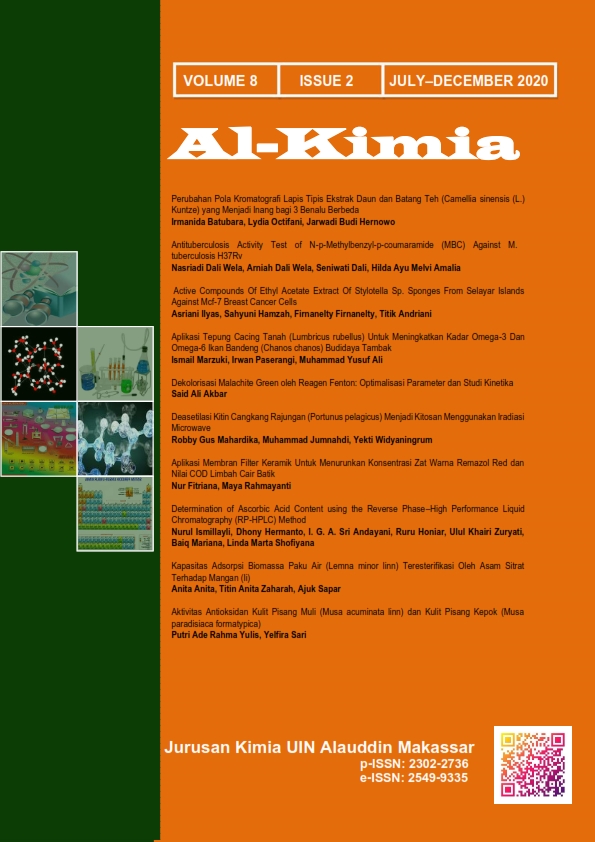Aplikasi Membran Filter Keramik Untuk Menurunkan Konsentrasi Zat Warna Remazol Red dan Nilai COD Limbah Cair Batik
Abstrak
Research on the application of ceramic filter membranes in reducing remazol red dye concentration and COD value of batik liquid waste has been carried out. The purpose of this study was to reduce the remazol red dye concentration and the COD value of batik wastewater using a ceramic filter membrane. The ceramic filter membrane used was made from clay and silica sand with variations in the number of additions of wood sawdust as much as 0, 1, 3, 5 and 7%. Then the porosity of the ceramic filter membrane was tested to determine the percentage of the pore volume that the ceramic filter membrane had. The ceramic filter membrane with the composition of clay, silica sand and 1% wood sawdust was the most optimum in reducing remazol red dye up to 86.68% and reducing COD value up to 97.87%.
Keywords: filtration, remazol red, COD, ceramic filter membranes, batik liquid waste
##plugins.generic.usageStats.downloads##
Referensi
Agmalini, Lingga, dan Nasir. 2013. Peningkatan Kualitas Air Rawa Menggunakan Membran Keramik Berbahan Tanah Liat Alam dan Abu Terbang Batubara. Journal Teknik Kimia, 10 (2).
Amin, M. dan Irawan, B. 2008. Pengaruh Tekanan Kompaksi Terhadap Karakterisasi Keramik Kaolin Yang Dibuat Dengan Proses Pressureless Sintering. Traksi. 8(1): 40-54.
Ekowati, G. W. dan Rahmayanti, M. 2019. Kajian Desorpsi Zat Warna Indigosol Blue Dari Adsorben Humin Hasil Isolasi Tanah Gambut Riau, Sumatera, Analit: Analytical and Environmental Chemistry, 4(2), 68-75.
Fuadah, S.R. dan Rahmayanti, M. 2019. Adsorpsi-Desorpsi Zat Warna Naftol Blue Black Menggunakan Adsorben Humin Hasil Isolasi Tanah Gambut Riau, Sumatera. Analit: Analytical and Environmental Chemistry, 4(2), 59-67.
Hubaidillah, Othman, Tai, Jamalludin, Yusuf, Ahmad, Rahman, Jaafar, Kadir, dan Harun. 2020. Novel Hydroxyapatite-Based Bio-Ceramic Hollow fiber Membrane Derived from Waste Cow Bone for Textile Wastewater Treatment. Joural Chemical Engineering Journal (2020) 122396.
Latifah, W.N. dan Rahmayanti, M. 2020. Desorption of Indigosol Blue from Humic Acid Coated Fe3O4 Particles, in Proceeding International Conference Science and Engineering 3, 169-170.
Murniati, Tri dan Muljadi. 2013. Pengolahan Limbah Batik Cetak Dengan Menggunakan Metode Filtrasi-Elektrolisis Untuk Menentukan Efisiensi Penurunan Parameter COD, BOD, dan Logam Berat (Cr) Setelah Perlakuan Fisika-Kimia. Jurnal Ekuilibrum, 12(1), 27-36.
Nainggolan, Purluhutan Ricardo. 2015. Pengendalian Fouling pada Sistem Pengolahan Air Berbasis Membran. Bandung: Jurusan Teknik Kimia, Fakultas Teknologi Industri, Institut Teknologi Bandung.
Prameswari, Tania. 2013. Sintesis Membran Kitosan-Silika Abu Sekam Padi untuk Dekolorisaso Zat Warna Congo Red. Semarang; Universitas Negeri Semarang.
Prandini, M. N.dan Rahmayanti, M. 2020. Effect pH Adsorption of Naphtol Dye Using Humic Acid Adsorbent Result of Peat Isolation from Kalimantan, in Proceeding International Conference Science and Engineering 3, 147-151.
Rahmayanti, M., Yunita, E., dan Putri, N. F. Y. 2020. Study of Adsorption-Desorption on Batik Industrial Dyes (Naphthol Blue Black) on Magnetite Modified Humic Acid (HA-Fe3O4), Jurnal Kimia Sains dan Aplikasi, 23(7), 244-248.
Santi G.C. dan Rahmayanti, M. 2019. Effect of Solution pH to Indigosol Blue Adsorption on Humic Acid Isolated from Kalimantan Peat Oil, in Proceeding International Conference Science and Engineering 2, 193-195.
Tolba, Bastaweesy, Ashour, Abdelmoez, Khalil dan Barakat. 2016. Effective and Highly Recyclable Ceramic Membane Based on Amorphous Nanosilica for Dye Removal from The Aqueous Solutions. Arabian Journal of Chemistry. King Saud University:
Wahyuni, Anis Tri. 2014. Sintesis Biosorben Dari Limbah Kayu Jati dan Aplikasinya Untuk Menjerap Logam Pb Dalam Limbah Cair Artifisial. Skripsi. Universitas Negeri Semarang.
Wenten, I.G, Hakim, Khoirudin dan Aryanti. 2013. Polarisasi Konsentrasi dan Fouling pada Membran. Bandung: Institut Teknik Bandung.
Authors who publish with this journal agree to the following terms:
1) Authors retain copyright and grant the journal right of first publication with the work simultaneously licensed under a Creative Commons Attribution License that allows others to share the work with an acknowledgement of the work's authorship and initial publication in this journal.
2) Authors are able to enter into separate, additional contractual arrangements for the non-exclusive distribution of the journal's published version of the work (e.g., post it to an institutional repository or publish it in a book), with an acknowledgement of its initial publication in this journal.
3)Authors are permitted and encouraged to post their work online (e.g., in institutional repositories or on their website) prior to and during the submission process, as it can lead to productive exchanges, as well as earlier and greater citation of published work (See The Effect of Open Access).


